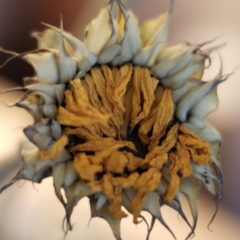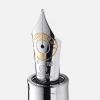Search the Community
Showing results for tags 'chemistry'.
-
Noodler's amazes me. The color options, the shading, the water resistance (some-but-not-all inks). I have nothing but respect for Mr. Tardif. This thread is one of wonderment, amazement, and homage. One thing that irritates me, however, is that he does not offer a true bulletproof CYMK set (with the obvious exception of Black.) This means that the inks I want to make for myself won't be bulletproof. And bulletproofness is a sticking point for me, or at least water resistance. (I don't write anything worth forging anyway, so for the time being let's throw out bleach/acetone/ammonia/..... resistance.) So for the chemists in the room: how can one make a water-resistant, dye-based ink? The dye retailers I've called don't think it can be done. (They mostly retail to cloth dyers, so their lack of expertise in inks isn't surprising, but cellulose reactivity is cellulose reactivity; all cellulose-reactive dyes I've come across require activation with a base like soda ash or NaOH, and then are unstable in a bottle. ) The closest I've come to an explanation of Tardif's dyes on this forum is this: Unfortunately I saved the quote but not the link in my notes. I believe Chemyst stepped in and countered that yes, they are reactive dyes. We know that water resistant CYMK inks are possible, because De Atramantis makes them too. (Unfortunately they're very expensive here in the US.) So. Who wants to take a stab? What makes Bulletproof Black so bulletproof? How can one make a water resistant ink from a dye base? I'll offer some clues, or at least properties of Noodler's that I've noticed: --He offers (at least partially) water resistant blacks, and purples, and browns. (Though usually the water resistant component is black...) --He DOESN'T offer truly water resistant yellows or oranges. (Operation Overlord*) --He USED TO offer essentially CYMK inks from I think Swishers (Goldfinch for yellow, which he was "permanently sold out of" at one point, Hellbender Red, Brittania's Blue Waves -- see the Noodler's CYMK thread). He no longer does so. Is this lack of interest, or a change in availability, or....? --Noodler's likes to form bubbles in my bottles, indicating he uses A LOT of surfactant. This is also evidenced by the degree to which it nib creeps. So far I've: --Done patent searches related to inks (I still haven't found a single patent related to fountain pen inks; the ONE I was able to find seemed to talk about a "ball point fountain pen ink" which was odd.) There are lots of patents related to inkjets and ball points, but none specifically related to FPs. Most of the inkjet patents are pigment-related, but not all. --Done MSDS searches for major ink makers. I've learned some about what other stuff goes in ink, but the only actual dye I've found was a direct dye used in Pilot's rollerball inks. --Called Pro Chemical and Dye, DharmaTrading, and Keystone; the first 2 have no idea what I'm talking about (and think it's impossible); the last hasn't called me back yet. --Done general dye research, especially at . A list of threads worth reading if this topic encuriouses you too: Fabric Dye as a Basis for Ink: https://www.fountainpennetwork.com/forum/topic/269610-fabric-dye-as-a-basis-for-ink/ Make Your Own Ink https://www.fountainpennetwork.com/forum/topic/2183-make-your-own-ink/ The Open Source Ink Project: https://www.fountainpennetwork.com/forum/topic/227894-open-source-ink-project/ Physics Articles Related to FPs: https://www.fountainpennetwork.com/forum/topic/288121-fountain-pen-ink-behaviour-fountain-pen-physics-journal-articlesreferences/ Mixing Glycerine In Ink: https://www.fountainpennetwork.com/forum/topic/257406-mixing-glycerine-in-ink/ Surfactants in Ink for Improved Flow: https://www.fountainpennetwork.com/forum/topic/229403-surfactants-in-ink-for-improved-flow/ So.... thoughts?
- 39 replies
-
- ink making
- dyes
- (and 5 more)
-
My understanding is that fountain pen inks are either dye-based or pigment-based. Pigment inks are generally water-resistant if not waterproof; dye-based inks, generally speaking, are easily washed away by water (exceptions being iron gall and Noodlers inks, which afaik are dye-based but contain chemical additives of one kind or another which bind with or eat into the paper, rendering your writing water resistant even if some of the dye washes away). Dye-based inks are generally easy to manage; pigment inks and chemically-augmented dye-based inks have, to a greater or lesser degree, liabilities which make them trickier or riskier to use than standard dye-based inks (e.g. Bay State Blue somehow dissolved some of the plastic in a Kaweco slide-converter over the course of a year; KWZ IG Blue #1 completely gummed up the feed of a Lamy Safari when I left it in a drawer unused for a month; etc.). But I have learned through experimentation that if you add a small amount of a waterproof ink to a larger amount of dye-based ink, 4 times out of 5 the mixture will have enough water resistance for most practical purposes (i.e. it will preserve your writing if your notebook gets hit with a spilled drink, but I suppose you wouldn't want to use it for whatever it is artists do with fountain pens + watercolor paints and so forth) and also be less prone to generate the problems associated with the original waterproof ink. The obvious drawbacks to this approach are that ~20% of the time (ymmv) you get some kind of chemical reaction that wrecks the ink or even the pen, and that mixing inks makes refilling your pen a somewhat messier and more time consuming process than it would be otherwise. So why don't manufacturers just add a little bit of pigment to dye-based inks to make them more permanent? And why do so many pigment inks have to be so densely pigmented that they create clogging/hard start problems (e.g. R&K Lilly is a neat color, but in my experience it's basically unusable unless you want to constantly prime the feed and rinse the nib every other day -- by contrast, 50% R&K Lilly + 50% J. Herbin Lie de The works just fine as an everyday drawing/writing ink)? The either/or approach seems completely counterintuitive to me. Or am I completely mistaken about some/all of the above (which tbc is entirely possible 💁♂️)?
-
Hi all! I did a little essay on the chemistry of fountain pen inks for extra credit in my AP Chemistry class. I thought you might enjoy reading it as well. Please feel free to let me know if anything is wrong (I don't think there's anything wrong but I know there's chemists lurking on this forum) and enjoy! The Chemistry of Fountain Pen Inks Even in today’s increasingly digital society, writing and print publications remain ubiquitous parts of our daily lives. From completing chemistry homework to reading the newspaper, we are constantly in contact with words on paper. Although the structure of the paper is mostly consistent, even with seemingly different types, the inks used vary greatly and are impressive examples of chemical engineering applied to an important part of daily life. Inks are used for countless applications, but the two most common uses are printing and writing. Printing inks, which create the vibrant pages of textbooks, newspapers, and magazines, however, represent only one part of the ink family. The other, more chemically diverse branch of this family, is writing ink. The chemical makeup of inks has incredible variation between the types of pens the inks are designed for, and even within different inks for the same type of pen. The most strikingly variant and chemically interesting group of writing inks are those designed for use in fountain pens. Due to the feed system used in fountain pens to bring ink to the tip, or nib, of the pen, fountain pen inks must be solutions rather than pigment based like many of their ballpoint peers. The inks for fountain pen use must also be water soluble, not tinctures. This requirement stems from the nature of the material that the pen bodies are made from. Many pens, especially those from the early 20th century, are made from celluloid, ebonites, or other natural plastics, which are soluble in alcohol. Any tincture inks would damage these pens. Because of the unique requirements created by a fountain pen’s feed system and the materials used to make vintage pens, many fountain pen inks are made of several fundamentally similar ingredients. First and foremost, all are made mostly of water, the solvent of the ink. A solute that occurs in nearly all fountain pen inks is a water soluble aniline dye composed of a Nitrite group bound to a phenyl group, forming a basic amine, phenylamine. Although many of these dyes are actually more soluble as tinctures, they are dissolved in water to protect the pen materials, as discussed earlier. Other common solutes are surfactants to increase ink flow, biocide compounds to prevent fungal growth in ink, and glycerin to increase ink viscosity. Despite fundamental similarities and rigid requirements to protect pens, fountain pen inks manage to present a wide range of properties to the consumer. These features include greatly decreased freezing points, total permanence on paper, scents, color changes, and decreased drying times. Inks with lowered freezing points are formed by the addition of solutes that dissolve into multiple ions or ring-based covalent hydrocarbons (in the case of polar covalent solutes). Paper permanence is achieved through the addition of solutes that bond with the cellulose of the paper, ensuring that the ink remains permanently marked on the paper and fraud-proof. Scents are the easiest of the properties to create, made by adding ester based solutes formed by the reaction of carboxylic acid and alcohols to the ink solution. Color changing inks are formed by making an ink with multiple dyes, only one of which forms the type of permanent cellulose bond described earlier. When the ink is rinsed with water, all of the dyes except that which bonds with the cellulose wash away, “changing” the color of the ink on the page. Decreased drying times are created, counterintuitively, by adding higher surfactant levels than usual and increasing flow. This allows the ink to seep into the fibers of the paper faster, and stay wet and smudge-prone for a shorter period of time. Inks remain one of the most important parts of everyday life, and will for the foreseeable future. The chemical diversity is striking across different types of inks, for different applications. For fountain pen inks however, more unites the inks than differentiates them. Yet even with this surface level chemical uniformity, the addition of trace levels of different solutes allows fountain pen inks to come in a vast rainbow of colors and an array of special properties.
-

Iron Meet Gall: The Secrets Behind Ink In The 18Th Century - Historical Writing Series Part 2
peroride posted a topic in Inky Thoughts
https://youtu.be/P582srfq_14 Fantastic fun chemistry! I enjoyed that Brian uses red wine as an anti-microbial putting a different spin to the term vintage ink I want what he's drinking, err.. writing -
Greetings, folks, I'm Xander. I have a question about Iroshizuku ink. This may or may not be the place to ask this. Is Pilot Iroshizuku a low-sodium ink? According to a maintenance tech here in my fab, I can get my fountain pen fab-approved so long as it is low-sodium. Thanks!
- 17 replies
-
Hey There, I Know A Little Chemistry And Am Looking To Get Into Ink Making.
I_stole_my_own_username posted a topic in Inky Recipes
Hello there, As the title says I know some chemistry and am considering making my own ink. I am still in the initial steps, and am looking for resources, and not recipes. I have read through [this link on ink chemistry,](http://www.rsc.org/chemistryworld/Issues/2003/March/inkchemistry.asp) and am currently going through the resources provided at the bottom as well as their subsequent sources. However I am finding many of the links I click on take me to non-fountain pen ink sites, and so I was directed here by Goulet to find out more. Do you have any literature on Ink chemistry? Thank you for your replies -
My partner has access to a chemistry lab and there she could easily test my inks for their pH levels. Sometimes I hear discussions about this or that ink pH. Is it something anybody's really interested in? Because, for example, my partner tells me she'd require less than 1 ml of ink to test it for its pH level, so I could give her samples of the half-a-dozen inks I have without shedding a tear, and I could share the knowledge here (and whenever I buy and test more ink). But I'd like to know if there's a demand for this kind of information. After all, I'd be spending my ink and her time on this.




